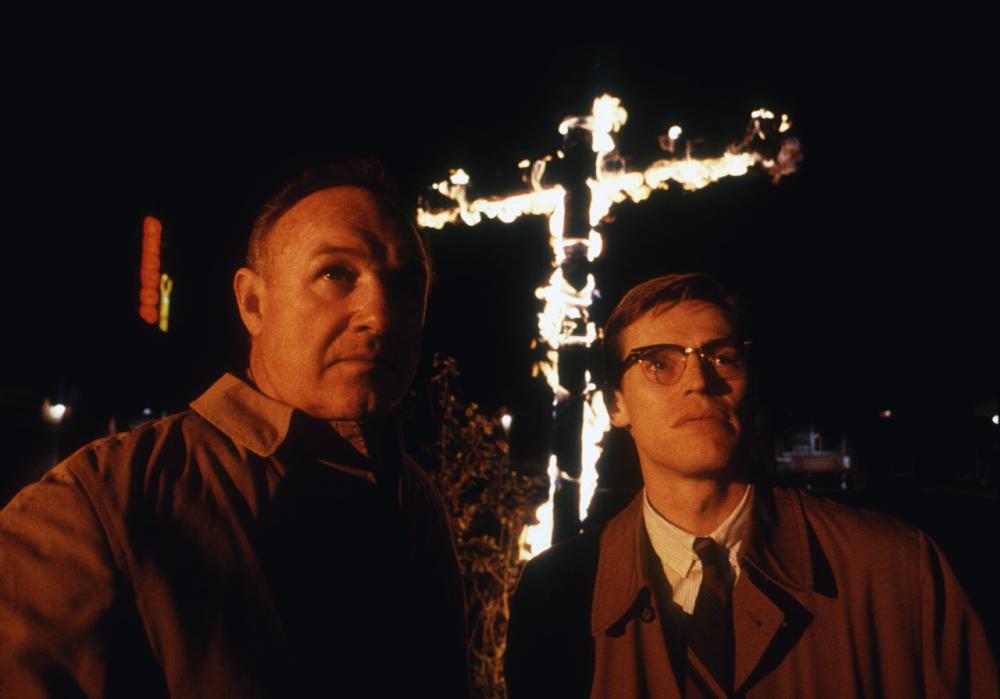Viewed in 2020, Alan Parker’s 1988 film “Mississippi Burning” is inherently flawed but undeniably compelling in its vivid and incendiary depiction of Southern racism during the 1960s. While there are a number of problematic aspects which definitely need to be addressed, the movie is still a first-rate crime thriller that skillfully thrusts us into that violent and dangerous period. The film’s many unforgettable moments resonate with an inconvenient fact that racism and its long, deplorable history is still alive and well in American society.
The story is told mainly through the viewpoint of two FBI agents sent to a fictional county in Mississippi for investigating the disappearance of three young civil rights activists in June 1964. Although their names are never mentioned throughout the film and they are merely named as “Goatee,” “Passenger,” and “Black Passenger” in the end credits, these activists in the film are clearly based on real-life civil rights activists James Chaney, Andrew Goodman, and Michael Schwerner, whose sudden disappearance in Mississippi lead to an extensive search and investigation led by FBI at that time.
When Agent Alan Ward (Willem Dafoe) and Agent Rupert Anderson (Gene Hackman) arrive in the county, they instantly sense that they are not so welcomed by many of local white people in the town, and are not surprised at all when they do not get much cooperation from the local sheriff and his deputies. The sheriff, who is your stereotypical sleazy Southern dude, insists that he and his deputies do not know anything, and he even suggests that the case is nothing more than a hoax perpetrated by the activists and their liberal associates who dare to meddle with the way of life in the South.
The activists came to the county to help local Black people on voter registration, and it goes without saying that they were targeted by a local racist group right from the very beginning, but nobody in the county wants to tell anything to Anderson and Ward. While many local white people are uncooperative and hostile to say the least, most of the local Black people are all the more silent because even a few seconds with the agents can lead to getting themselves lynched or murdered. This is a small town after all, and whatever they might say to the agents can be quickly spread around in the county.
As a guy who was once the sheriff of another small county of Mississippi, Anderson knows better, so he advises Ward not to cause too much disruption, but Ward sticks to the procedures while pushing harder in their ongoing investigation. More agents are brought into the town, and, after the car belonging to the missing activists is finally found somewhere outside the county, he brings in far more people for the following search all over the county.

Of course, the tension surrounding the county is consequently escalated day by day, as reflected by one heart-pounding montage alternating between the search process and a series of hate crimes happening here and there in the county. Thanks to the dexterous editing by Gerald Hambling and the pulsating electronic score by Trevor Jones, we become more unnerved by the accumulating conflict in the story. And cinematographer Peter Biziou, who deservedly won an Oscar for his work here in this film, gives us strikingly fiery moments dripping with the raging evil of racism on the screen. As shown from many of his notable films such as “Midnight Express” (1978), “Pink Floyd – The Wall” (1982), “Birdy” (1984), and “Angel Heart” (1987), director Parker was a master filmmaker who knew how to engross us with mood and details, and many locations appearing in the film are packed with that distinctive Southern atmosphere and texture while occasionally making us uneasy for the menace lurking behind their shabby façade.
In the meantime, the screenplay by Chris Gerolmo gives some insight into the source of the racial hatred that often shook up the American society during that period. As reflected by a personal story told by Anderson at one point, many of the racist white folks in the South including his own father let themselves be blinded and driven by hate, and that aspect is exemplified well by many racist bullies shown in the film. No matter how much they get away with their vicious hate crimes, they’re nothing but pathetic and hateful losers, and a bunch of notable characters actors including Brad Dourif, Stephen Tobolowsky, Pruitt Taylor Vince, and Michael Rooker effectively embody that loathsome aspect. While clearly recognizing the banality of evil observed from their racist characters, the movie often shows chilling moments of violence as required, and I assure you that these moments will make whatever you saw from “The Help” (2011) and “Green Book” (2018) look like a Sunday afternoon picnic.
However, despite its good intentions, the movie lacks the perspectives from its Black characters, who are, except for one outspoken boy who helps Ward and Anderson a bit, more or less than background details unless they are victimized by those racist villains in the film. Sure, the movie shows how much they are afraid or angry about what is happening to them, but it does not delve deep into that pain and frustration which has existed for more than 100 years; the film also seriously marginalizes the significant efforts of many civil right activists during that era, focusing instead on its FBI agent heroes. As a matter of fact, J. Edgar Hoover and his men were more interested in the private life of Martin Luther King Jr. than finding those missing activists, and it is undeniable that Gerolmo’s screenplay fictionalizes its real-life story too much as following genre conventions for maximum dramatic effects.
Nevertheless, the story itself, which can be regarded as your typical buddy cop tale, is captivating because of the strong personalities of its two main characters. Respectively taking very different approaches to their investigation, Anderson and Ward frequently clash with each other, but they eventually come to find a common ground when recognizing each other’s determination toward justice. Although their resulting tactics are morally and ethically questionable, they are fairly acceptable at least in the genre territory of the movie, and the electrifying dynamics between the two lead performers firmly hold the story to the very end. While Hackman effortlessly swings back and forth between his character’s laid-back amiability and unforgivingly righteous wrath, Dafoe somehow succeeds in burying himself completely in his character’s unflappable clean-cut appearance, and he effectively functions as a solid ground for his co-star’s showier acting.
The movie was also one of the early career high-points for Frances McDormand, who is poignant as Mrs. Pell, a local hairdresser who gives Anderson a tip on the whereabouts of the missing activists. Unlike her racist husband and many other people around her, she apparently feels wrong about the ongoing injustice in her town, and Anderson deliberately tries to appeal to her conscience step by step. In time, they come to feel something mutual between them. While facing the hard consequence from her subsequent choice, she reveals a surprising amount of will and strength behind her seemingly timid attitude, and McDormand and Hackman have a quietly touching scene where their characters indirectly recognize how much they are changed by the unexpected emotional development between them.
In spite of its inherent weak aspects including a glaring deficiency in African American perspectives, “Mississippi Burning” is a powerful visual presentation of racial hatred and its virulent terror, and it has recurred to me more than once during last decade. When I heard about those racist riots that happened right after the re-election of President Barack Obama in late 2012, I could not help but think of those searing images in the film, and they have been disturbingly amplified in my mind during next several years for the good reasons both I and you know too well. Racism is indeed not done with American society at all. But, despite my growing skepticism, I still hope there’s a chance for America and its people to overcome it.











